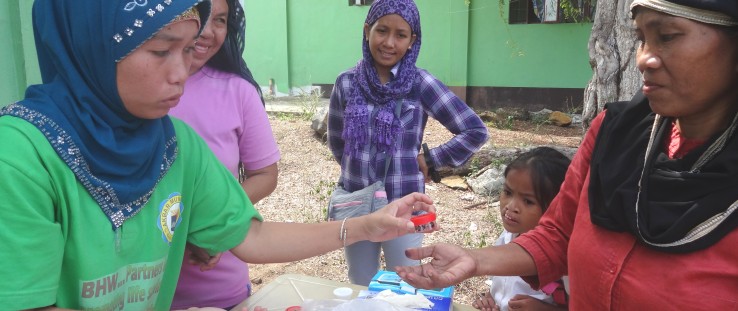 Informal laboratory workers in Basilan get supply of sputum cups for distribution to community members with TB symptoms.
DOH-HPCS
Informal laboratory workers in Basilan get supply of sputum cups for distribution to community members with TB symptoms.
DOH-HPCS
 Informal laboratory workers in Basilan get supply of sputum cups for distribution to community members with TB symptoms.
DOH-HPCS
Informal laboratory workers in Basilan get supply of sputum cups for distribution to community members with TB symptoms.
DOH-HPCS
In 2014, Maricel Capariño was pregnant with her second child when she suffered a miscarriage. Soon after, she was diagnosed with tuberculosis (TB).
“I became frail and sickly, and had no appetite,” remembers Capariño. She didn’t think that she would overcome the disease and lost all hope that she could ever become pregnant again.
Capariño is from Batangas, a bustling province near the Philippines’ capital region. Endowed with fertile agricultural lands, it is also an industrial growth center, fueled by petrochemical refineries, steel processing plants and the country’s second largest international seaport.
Despite the area’s robust economy, TB began spreading throughout Batangas’ population, threatening its stability and marking it as a TB hotspot in a nation already challenged by high TB incidence.
Nationwide, nearly 300,000 Filipinos contract TB annually and approximately 74 Filipinos die of the disease every day. And while the country made progress in fighting TB in the early 2000s, places like Batangas trailed behind. For example, by 2012, some regions met the 85 percent case detection rate, but Batangas reported detecting only 61 percent of cases.
“TB impacts people in their most productive years, rendering them unable to work or go to school, resulting in economic losses of $180.7 million annually,” says USAID/Philippines Mission Director Gloria D. Steele. “Eliminating TB can remove the binds that prevent families from contributing to their communities and their country.”
In 2012, USAID started the five-year, $28 million Innovations and Multi-Sectoral Partnerships to Achieve Control of TB (IMPACT) program across the Philippines to reduce TB prevalence and increase TB detection rates. The program is implemented by a local partner, Philippine Business for Social Progress.
“We worked with the Batangas Provincial Health Office to identify and address gaps in the system,” said Dr. Belfrando Cangao, IMPACT chief of party. “We reviewed records and interviewed program managers, service providers, TB patients and local officials, which revealed a cache of insights, practical suggestions and evidence for a rational and focused response.”
What led to the province’s poor TB program performance? For one, says Cangao, TB diagnosis was not readily available. With limited resources, municipal governments could not hire medical technologists, so there was no one to run tests and interpret results. The few medical facilities equipped for TB patients were out of reach for villagers, who faced mountainous roads, limited transportation and expensive fares to visit city treatment centers.
Meanwhile, just a handful of trained community volunteers could supervise daily intake of anti-TB medicines, often resulting in patients discontinuing treatment. They went uncured, died or developed the disease’s drug-resistant form.
IMPACT assisted rural health units to establish remote testing stations and taught village health workers about infection control and records management. The new stations included a system for transporting test results, financial support from local governments, supply chain management, quality assurance, and monitoring and evaluation. These efforts eliminated the need for rural villagers to travel for TB diagnosis, ensuring timely diagnosis and completion of their nine-month TB treatment.
At the same time, USAID worked with hospitals to improve their ability to treat TB. In 2012, only two of the province’s 55 private hospitals were implementing the directly observed treatment short-course, or DOTS, strategy. With existing resources, hospitals could readily provide or refer patients for TB care. USAID trained 36 private hospitals to diagnose TB, manage TB patients and set up a referral system with public DOTS facilities.
USAID also engaged private workplaces, establishing TB control programs for their employees, an action backed by the Philippine Government’s Department of Labor and Employment, which mandates that all private establishments formulate a TB policy and program. Today, 27 private companies in Batangas have established TB programs, including AG&P, a Filipino company that employs over 3,000 craftsmen, engineers and technicians to work in the country and abroad.
USAID also helped establish the Provincial Multisectoral Alliance (PMSA) to expand public and private sector participation.
For example, the Adventist Community Service mobilizes church members to educate communities on TB and refers individuals with chronic coughs to DOTS facilities. Meanwhile, Lyceum of the Philippines, a leading Batangas university, integrated a basic TB course in its nursing curriculum. As part of their community service, nursing students conduct TB education and refer presumptive TB cases to the nearest DOTS facility.
Health Care Housecalls
Leading the province and its push to control TB is Batangas Governor Vilma Santos-Recto. A former actress in Philippine cinema, she is committed to looking after the welfare of the people.
“The health of the people of Batangas is one of my main priorities,” says Santos-Recto. “When I learned the magnitude of the TB problem and its effects on my constituents, especially the children, I saw the good that the PMSA would do.”
Municipal officials followed Santos-Recto’s leadership. In 2012, only one municipality allocated funds toward TB control. Today, 14 have passed similar policies.
Many of these policies allocate funding for community health volunteer allowances. Jeffrey Bolaños is one of 8,000 village health volunteers who received training on TB-DOTS and interpersonal communications. His local government provides him $45 a month, ensuring he and other volunteers can sustain their work and that TB care is available every day of the week.
Bolaños helped Maricel Capariño when she was diagnosed with TB.
“He came to my house every day for six months to ensure I took my medication,” says Capariño. “He cheered me up when I felt discouraged. Without him, I wouldn’t have completed my treatment and been given a new lease on life, or dream again of having another baby.”
Today, the people of Batangas are invigorated and empowered to detect and cure TB. The province’s detection rate surged from 61 percent to 92 percent, resulting in Batangas earning top honors in the region from the Department of Health in 2014 for its TB performance.
“We work with indigenous people, families from conflict-affected areas of Mindanao, midwives and even prison inmates, leaving no population behind,” Steele said. “Access to health care must reach far and wide for our efforts to have lasting impact.”
Amid all of the partnerships forged and policies adopted, it is the health workers like Bolaños, and countless other nurses, teachers, faith leaders and business and government advocates that form the backbone of the nation’s ability to better detect TB and accompany patients in their journey of recovery. “I’m only too happy to help,” says Bolaños, adding that he is honored to save lives and help his village.
Saniata P. Masulit, Research, Information and Communication Officer for IMPACT, contributed to this article.








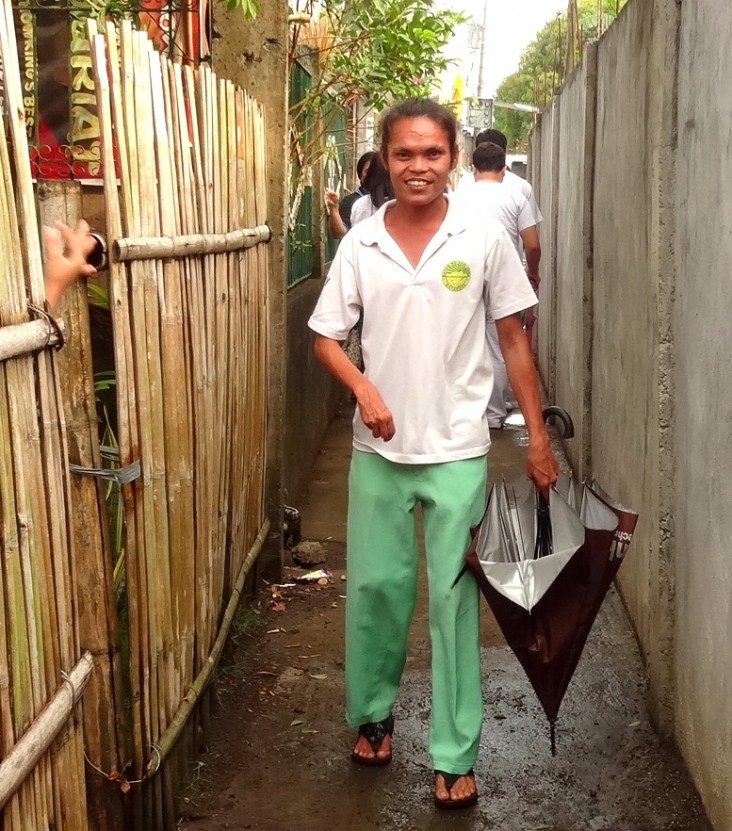
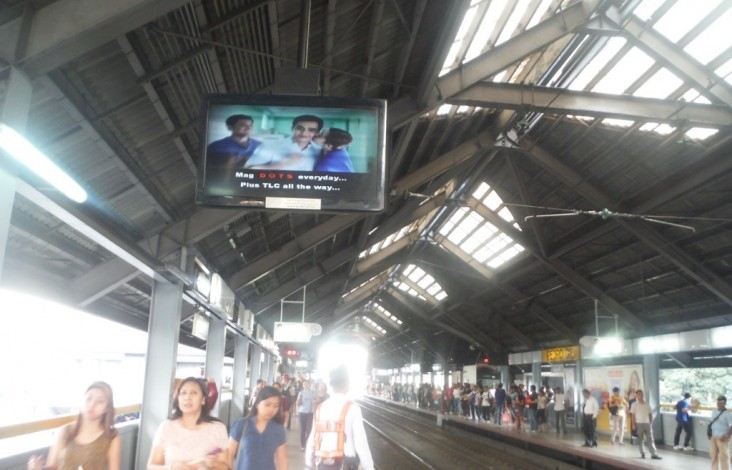
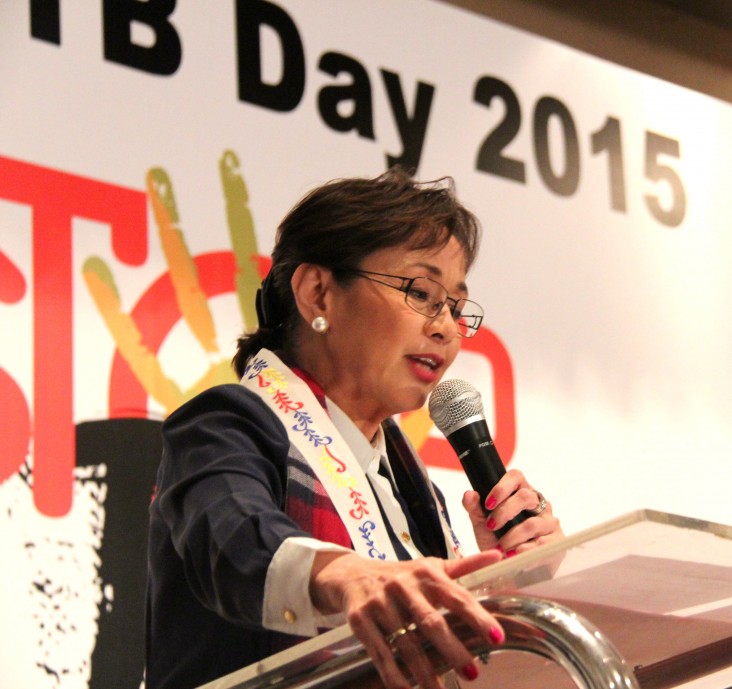

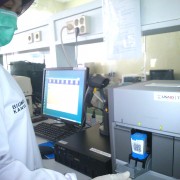

Comment
Make a general inquiry or suggest an improvement.